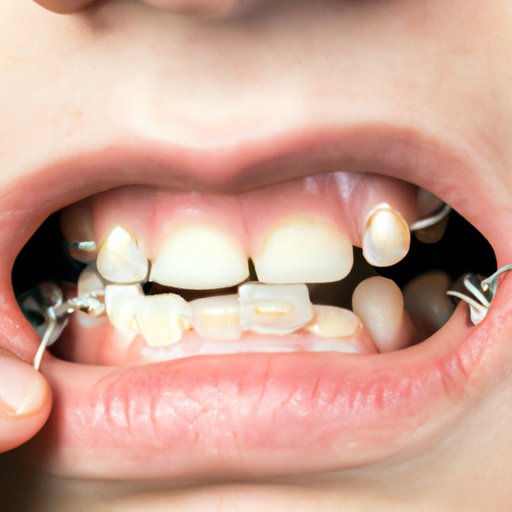Introduction
If you have braces, flossing is just as important as brushing your teeth. Braces make it harder to remove plaque, bacteria and food particles from between your teeth, which can lead to tooth decay and gum disease. Flossing with braces requires patience and practice, but it’s an essential part of maintaining good oral hygiene. In this article, we will provide you with tips and an easy step-by-step guide on how to floss with braces, including the best tools to use and common mistakes to avoid.
Step-by-Step Guide
The right way to floss with braces is to use a floss threader. This tool has a flexible tip that allows you to thread floss under the wires and between brackets. Here’s how to do it:
- Cut 18-24 inches of floss and thread one end through the threader.
- Hold the floss threader in your hand and guide the pointed end underneath the wire of your braces until the floss is in place between two teeth.
- Gently move the floss up and down, making sure to curve it against each tooth to remove plaque and debris.
- Remove the floss threader from your mouth and repeat the previous steps until you’ve flossed all of your teeth.
It’s important to take your time and floss carefully, especially around the wires and brackets. Don’t rush or be too forceful, as this can damage your braces or cause discomfort. If necessary, use a mirror to see what you’re doing.
Another option is to use a pre-threaded flosser that has a hard plastic end with a short piece of floss attached. This tool is easier to use and more convenient, but may not be as effective as a floss threader, especially for people with tightly spaced teeth or crowded teeth.
You can also use waxed or unwaxed floss, or dental tape, depending on your personal preference. Waxed floss glides more easily between teeth, while unwaxed floss can clean more effectively. Dental tape is effective for wider gaps between your teeth or larger spaces between brackets.
Choosing the Right Flossing Tool
Here are some options you can choose from:
- Interdental brushes– These are small, cone-shaped brushes that can clean the spaces between your teeth, wires, and brackets. They are great for removing small bits of food, and they’re gentle on gums.
- Floss threaders– As explained earlier, these are flexible devices that are used to thread floss under the wires. They are available in most drug stores or supermarkets.
- Waterpiks– These use a jet of water to remove debris and bacteria. They are especially helpful for people with braces because the water jet removes bacteria and food particles between teeth.
Choosing the right flossing tool depends on your preference and the type of braces you have. Talk to your orthodontist for recommendations on the best tools to use.
Common Mistakes to Avoid
Some common mistakes to avoid when flossing with braces include:
- Using too much pressure, which can result in damaging wires and brackets.
- Skipping flossing, which can lead to food buildup and decay.
- Using the wrong flossing tool, which can be ineffective or difficult to use.
To avoid these mistakes, take your time when flossing, use the recommended tools, and floss at least once a day. Make sure to thoroughly rinse your mouth with water after flossing.
Benefits of Flossing with Braces
Flossing with braces has many benefits which include:
- Preventing gum disease and tooth decay
- Maintaining oral hygiene and fresh breath
- Reducing the risk of enamel demineralization (white spots on teeth)
- Preventing tooth sensitivity caused by the buildup of food and plaque
Studies have shown that flossing is an effective way to maintain good oral hygiene and overall health.
Personal Experience
As someone who had braces, flossing was initially challenging for me. However, with practice and the right tools, I was able to master it. I found that using a floss threader and waxed floss made the process easier and more effective. I also made sure to floss slowly and be careful around the wires and brackets. Don’t be discouraged if it takes time to get used to flossing with braces. It’s a skill that requires practice, and the benefits of good oral hygiene are worth it.
Conclusion
Flossing with braces is essential for maintaining good oral hygiene, preventing tooth decay, and gum disease. Make sure to use the right tools, be gentle, and take your time when flossing. With practice and patience, you can master the skill of flossing with braces. Remember, a healthy smile starts with good oral hygiene!
If you need additional advice or tips on flossing with braces, talk to your orthodontist or dentist.
